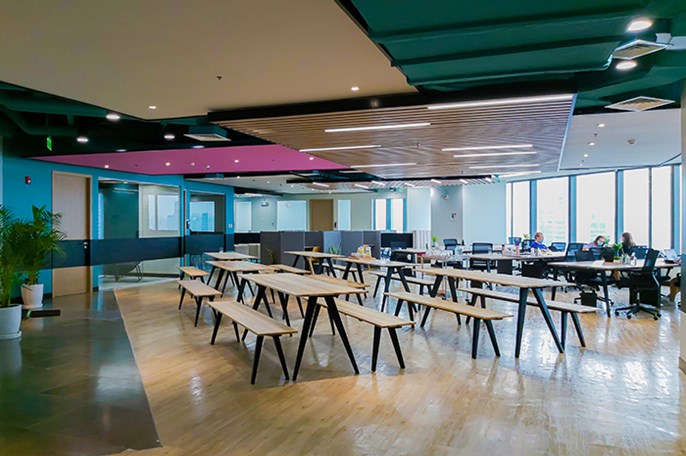How Workspaces Can Evolve Along With A Business Life Cycle
5/17/2021 | By Marella Gimenez

Did you know that the design of workspaces affects employee productivity, efficiency, and collaboration? Workspace planning is not all about elevating your office’s aesthetic appeal. It is concerned with space usage, functionality, systems, and more. Office spaces are environments that develop their own natural flows. People tend to build systems to work efficiently. However, you cannot rely on that alone.
This is where space management and planning come into play. To come up with a strategic floor plan for your workspace, you must know the basics of space management and planning—the two come hand in hand. While specific fields exist to carry out this job description, such as Facility Management, some businesses cannot afford their professional services.
Workplace management is concerned with the physical work environment in the office. People in this field focus on space allocations, health and safety protocols, security, employee workstation assignments, office furniture, supplies, and technology. Where a specific department is located, coming up with seating arrangements, choosing ergonomic furniture, and office layouts are just some of the things that concern space management and planning.
Furthermore, they are tasked with crucial decisions about the physical aspect of the workspace. They need to identify what a specific space is for and consider its relationship with adjacent areas. That is an important starting point when it comes to space management and planning. An office layout must be deliberately designed. The functionality of each space and where they are located can affect overall work productivity.
The floorplan design is something that is often overlooked. However, it can make all the difference in a work environment. It must be designed in a way that it can adapt to the future needs of a business as it grows. Foresight is an essential element in this case because changes must be accommodated. Then, the look of the space should be carefully determined. Will you adopt similar designs for all rooms? Should they have a different format? All of these will affect the overall mood and work of an employee.
How Office Design Can Help Navigate The Company’s Change

Change is the only thing you are sure of in the world of business. Companies deal with many transformations and new developments. The ability for them to adapt is now crucial amid ever-evolving technology, transformation in work structures and norms, market shifts, among others.
For growing businesses, change is sooner than you think. Your business needs will shift as the scope and scale of your business grows. The way you design your office can either make it easier or more challenging for you to adapt to technological and market changes and have room for growth. With these things in mind, you need to prepare your office space accordingly.
Flexibility and adaptability are the key concepts in designing an office that will help navigate change. It means that your design must be ready to accommodate growth and depression. Can you easily rework your office design when you need more space for new hires? What will your office space look like if you need to downscale?
Office design that considers change as part of the planning is how it can help your company. What type of furniture do you have in your workplace? Can they easily be moved and adjusted? Are there biophilic elements? Do employees have the chance to share a desk or work solo? Does the design encourage interaction and movement? These are just some of the things that can help you navigate change.
Don’t forget the virtual office and workforce. It is an equally essential part of office design. Providing the right technology will enable your employees to stay connected, regardless of however they choose to work. Make sure that you also include flexible technology in your design to meet your changing needs.
Workspaces Based on Your Business Life Cycle
The needs of your business will vary depending on where you are in the business life cycle. Therefore, how you plan and envision your workspace will adjust accordingly. Understanding where you are will help you identify your needs and prepare the appropriate strategies.
Seed
Every company begins at the seed and development stage. At this point, you have an idea, and you are just starting to conceptualize and test everything. Before you fully delve in and take the risk, the seed stage is where you will gather feedback and advice from as many sources as you can, from family and friends to mentors, business associates, and specialists.
Technically, this is the stage wherein you find ways to gather the necessary resources to officially launch your business. It is when you really dive in and assess whether or not you have a feasible business idea.
Startup
After the assessment, when you feel confident and ready to launch your business, the startup stage is the most crucial and riskiest business life cycle. You must power through all the challenges while making sure that you are making the right moves. However, it’s easy to stay focused on the product you are selling or the service you are offering.
What you do here will establish the foundation of your business, and that goes for how you imagine the looks and processes of your workspace. In this stage, you must ensure that every one of your resources are being used properly. There must be effective systems in place so that you can accurately measure and monitor your business performance. While it’s normal to incur losses at this stage, you should have space management and planning strategies to keep track of the physical assets in your business.
Again, adaptability is critical in this stage. Launching a business will require you to manage your financial resources and operational processes effectively if you want to move onto the next business life cycle.
Growth and Establishment
This is when you gain positive sales growth. The plans you've made in the startup phase influence your needs here. Moreover, this phase can get overwhelming real quick, and as a business owner, you must keep up.
Your workspace design must be able to adapt to the changes brought about by growth. As your business grows, so do your operations. Many entrepreneurs need to juggle multiple functions all at once - from accounting to employee management. Interestingly enough, some small businesses begin facilities management at this stage.
You must solidify your business at this point. Your workspaces should drive productivity, maintain employee wellbeing, and promote collaboration. Moreover, this is when you begin hiring new people. Many business owners rely on the remote workforce when there is not enough office space, and you can't afford to expand. Staff leasing and outsourcing are very common here because they serve as an extension to the team and help growth.
To further establish your company, you should hire the right people with skills to complement your company's potential. Should you hire more people? Is outsourcing a better option given the company's resources? How you design the systems in your workplace and make use of resources is highly crucial.
On the other hand, reflect upon your current office space. Sometimes, companies miscalculate the office space they need, which can negatively impact financial resources and employee productivity. Plus, this is where you can see how effective your office space planning is and if these spaces provide your employees’ needs to work effectively. Observe and take note of how space is used and where you think you need to modify it.
Expansion
Workspace management plays another crucial role here. Things will fall under a routine-like structure. There is a certain level of stability in the expansion stage, and you might even be thinking about expanding your horizons.
However, people tend to fall complacent at this stage. Careful space planning and management are still required to increase the likelihood of your success. Remember, change is the only thing constant in the business world.
Decline and Exit
Sometimes, things are out of your control. Revenue may decline no matter how solid your foundation was before. When this happens, innovation is necessary for all aspects. In this stage, be ready to tackle renewal efforts if you wish to continue.
How KMC Flexible Workspaces Can Help Businesses Adapt
Ever since the pandemic changed the way we work, businesses have found ways to adapt. Now, the future of work lies within scalable office spaces.
Having a scalable office space is beneficial to any type of business. It makes it easier to modify and restructure your office space according to your current realities. It’s also an affordable option for companies looking for short-term office spaces! With these, you can quickly scale up or down as needed.
Here at KMC Solutions, we offer flexible workspaces designed to accommodate entrepreneurs, startups, and freelancers at any stage. From private to virtual offices, your business needs will indeed be met!
The Best Office Space Solution
Office space solutions are a great alternative to traditional working spaces. It's perfect for small to medium-sized businesses!
If you're looking for a service that can handle all your changing needs, contact KMC Solutions. We will provide you with the most effective solution based on what you need to grow.




